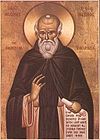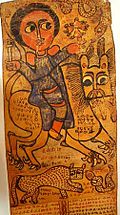Eastern Orthodox liturgical calendar
This article includes a list of general references, but it lacks sufficient corresponding inline citations. (May 2019) |
| Part of a series on the |
| Eastern Orthodox Church |
|---|
| Overview |
The Eastern Orthodox liturgical calendar describes and dictates the rhythm of the life of the
There are two types of feasts in the Orthodox Church calendar: fixed and movable. Fixed feasts occur on the same calendar day every year, whereas movable feasts change each year. The moveable feasts are generally relative to Pascha (Easter), and so the cycle of moveable feasts is referred to as the Paschal cycle.
Fixed feasts
The following list of dates links only to fixed feasts of the
These important notes should be remembered in using the following calendar:
- For the day in the modern Gregorian Calendar, on which churches following the Julian Calendar celebrate any fixed date's commemoration, the 13 days which were lapsed to correct the calendar to the seasons must again lapse, by adding the 13 days to the dates below. For example, Christmas Day (December 25) on the Julian Calendar falls on January 7 of the modern Gregorian Calendar.
The number of days by which the Gregorian calendar differs from the Julian calendar is currently 13, but will increase to 14 on March 1, 2100. Over the course of future centuries, the difference will continue to increase, limitlessly.
- For those churches which follow the Revised Julian Calendar, the dates below correspond exactly to the dates on the Gregorian Calendar.
The Eastern Orthodox liturgical year begins on September 1.
Moveable feasts
Great Feasts
There are Twelve Great Feasts throughout the church year—not counting Pascha, which is above and beyond all other feast days. These are feasts which celebrate major historical events in the lives of Jesus Christ or the
- Palm Sunday (the Sunday before Pascha)
- Ascension(forty days after Pascha)
- Pentecost (fifty days after Pascha)
The other Great Feasts are on the Fixed Cycle:
- The Nativity of the Theotokos — 8 September [O.S.21 September]
- The Elevation of the Holy Cross — 14 September [O.S. 27 September]
- The Presentation of the Theotokos — 21 November [O.S.4 December]
- The Nativity of the Lord — 25 December [O.S.7 January]
- The Theophany (Epiphany) of the Lord — 6 January [O.S.19 January]
- The Presentation of the Lord — 2 February [O.S.15 February]
- The Annunciation — 25 March [O.S. 7 April]
- The Transfiguration — 6 August [O.S. 19 August]
- The Dormition (Falling Asleep) of the Theotokos — 15 August [O.S.28 August]
In addition, the feast day of the patron saint of a parish church or monastery is counted as a Great Feast, and is celebrated with great solemnity.
Liturgical seasons
In addition to Great Lent, there are three other lesser lenten seasons in the church year:
- Nativity Fast (40 days in preparation for the Feast of the Nativity of our Lord)
- Apostles' Fast (variable time from the second Monday after Pentecost until the Feast of Saints Peter and Paul)
- Dormition Fast(2 weeks from 1 August to 14 August in preparation for the Feast of the Dormition of the Theotokos)
The season from the Sunday of the Publican and Pharisee (three weeks before the Great Lent) through Holy Saturday is called Triodion, while the season from Pascha through Pentecost is called the Pentecostarion.
Printed calendars
Because of the complexity created by the intersection of the various cycles, a number of Orthodox institutions will print an annual calendar (Russian: Spisok) which contains
See also
References
- For saints, feasts, and other commemorations:
- Complete lives of the saints for every day of the Byzantine liturgical year
- Lives of the Saints and Feast days Search at Greek Orthodox Archdiocese of America
- Orthodox Calendar at Holy Trinity Russian Orthodox Church
- Where to learn and purchase Orthodox Liturgical Calendars Archived 2019-07-04 at the Wayback Machine
- For scriptural readings:
- The Orthodox Study Bible. Nashville, Tennessee: Thomas Nelson Publishers, 1993: 771-780


